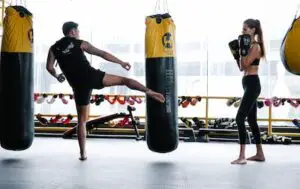Krav Maga is a self-defense system that was developed for the Israeli Defense Forces. It is designed to be effective in real-world scenarios and focuses on practical techniques that are easy to learn and apply. Although Krav Maga schools can be found all around the world, not everyone has access to one. Fortunately, it is still possible to train for Krav Maga at home solo. In this article, we’ll outline some helpful tips on how to do so.
What Is Krav Maga?
Krav Maga is a self-defense system that was developed in the late 1930s by Imi Lichtenfeld, a Hungarian-Israeli martial artist who had a background in boxing, wrestling, and Jiu-jitsu. The system was designed for the Israeli Defense Forces and is based on realistic scenarios that soldiers could face in the field. It emphasizes practical techniques that are easy to learn and apply.
Can Krav Maga Be Learned Online?
While it is always best to have a trained instructor to guide you, it is possible to learn Krav Maga online to some extent. There are many online courses available, but it’s important to choose a reputable one that has certified instructors and offers feedback on your progress.
What Are the Basic Techniques for Krav Maga?
Krav Maga is a self-defense system developed for the Israeli military that focuses on practical techniques for real-world situations. It combines elements of various martial arts and fighting styles to create a comprehensive and effective method of self-defense. Here are some basic techniques commonly taught in Krav Maga:
- Strikes: Krav Maga emphasizes powerful strikes to quickly disable an opponent. Basic strikes include punches, elbows, knees, and kicks targeting vulnerable areas such as the groin, eyes, throat, and vital organs.
- Blocks and defenses: Techniques for blocking and defending against punches, kicks, and other attacks are essential in Krav Maga. These defenses aim to redirect or neutralize incoming strikes while simultaneously countering and gaining control of the attacker.
- Joint locks and manipulation: Krav Maga incorporates joint locks, twists, and manipulation techniques to control an opponent’s limbs. These techniques can be used to restrain or disable an attacker by applying pressure to vulnerable joints such as the wrist, elbow, or shoulder.
- Throws and takedowns: Learning how to efficiently take an opponent to the ground is crucial in Krav Maga. Throws and takedowns allow you to quickly disable an attacker and create distance for further action or escape.
- Ground fighting: In a self-defense scenario, there may be situations where you end up on the ground. Krav Maga includes techniques for ground fighting, such as escaping from under an attacker, defending against strikes, and employing submissions and chokes.
- Defenses against weapons: Krav Maga teaches techniques to defend against various weapons such as knives, sticks, and firearms. These techniques focus on quickly neutralizing the threat, disarming the attacker, and creating an opportunity for escape.
- Multiple attackers: Krav Maga recognizes the possibility of facing multiple attackers and provides strategies to deal with such situations. These techniques involve using positioning, footwork, and quick strikes to efficiently neutralize threats.
- Situational awareness and prevention: Alongside physical techniques, Krav Maga emphasizes situational awareness and the importance of avoiding potential dangers whenever possible. Recognizing and de-escalating confrontational situations is a fundamental aspect of Krav Maga training.
How Can I Train for Krav Maga at Home?
If you want to train for Krav Maga at home, you’ll need to focus on developing your speed, strength, endurance, and technique. Here are some ways to do that:
– Shadowboxing: practice your strikes and defenses by shadowboxing in front of a mirror
– Heavy bag work: use a heavy bag to work on your striking technique and power
– Bodyweight exercises: do push-ups, squats, lunges, and other exercises to build strength and endurance
– Cardiovascular training: run, cycle, or do other cardio exercises to improve your stamina and endurance
– Resistance training: use resistance bands or weights to build strength and power
How Can I Practice Krav Maga Techniques without a Partner?
While Krav Maga is designed to be practiced with a partner, it is still possible to practice on your own. Here are some techniques you can practice solo:
– Striking: practice your punches, kicks, elbows, and knees on a heavy bag or shadowboxing
– Defenses: practice defending against imaginary attacks by visualizing an opponent and practicing your defenses
– Throws and takedowns: practice your footwork and balance by doing shadow wrestling drills
– Joint locks and pressure points: practice on a dummy, pillow, or other soft object to improve your technique
What Are the Benefits of Training for Krav Maga?
Krav Maga is an effective self-defense system that can help you feel more confident and prepared in real-world scenarios. Some of the benefits of training for Krav Maga include:
– Improved fitness and health
– Increased self-confidence and self-esteem
– Better stress management and reduced anxiety
– Improved focus, discipline, and mental clarity
– Enhanced situational awareness and self-defense skills
Conclusion
Krav Maga is an effective self-defense system that anyone can learn, regardless of their age, gender, or fitness level. Although it is best to have a trained instructor to guide you, it is still possible to train for Krav Maga at home solo. By practicing your techniques, building your strength and endurance, and staying focused and disciplined, you can develop the skills and confidence you need to protect yourself and others in real-world scenarios.





